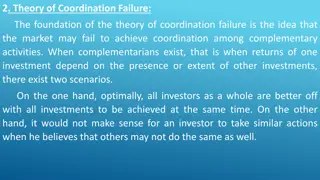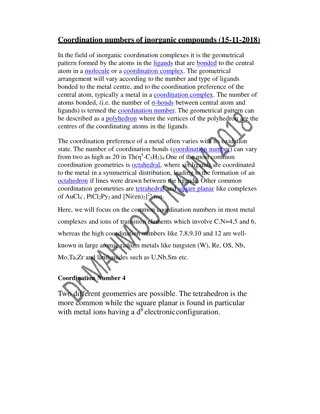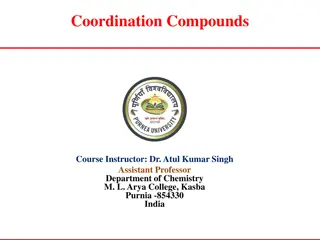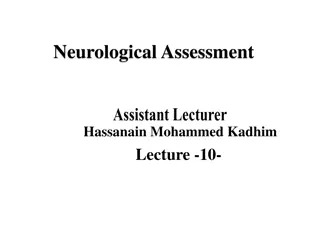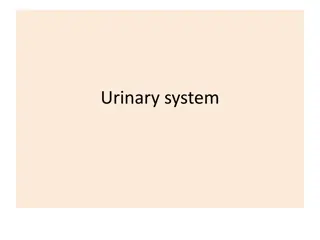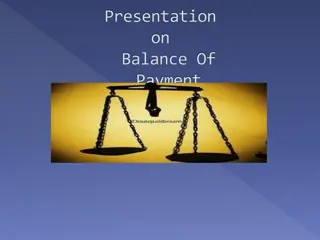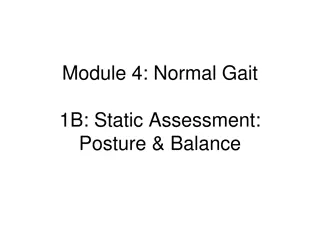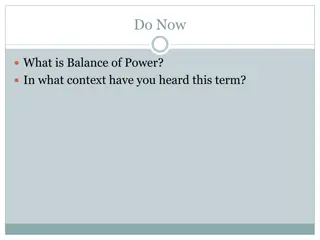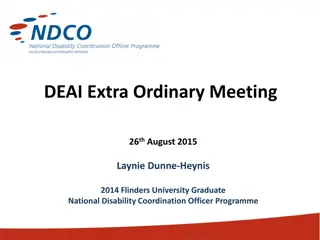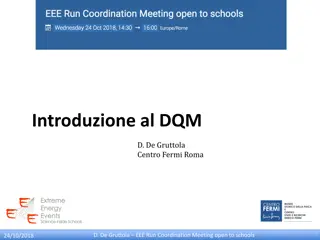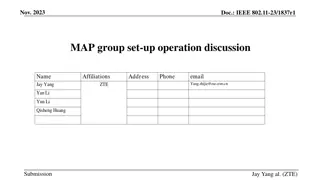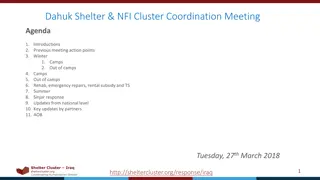Understanding Coordination and Balance in Health Sciences
Coordination involves selecting the right muscles at the right time for proper action, while balance is the process of maintaining body position equilibrium. Various aspects like dexterity, agility, and visual-motor coordination play crucial roles. Co-ordination exercises aim to enhance motor behavior and proprioceptive feedback. Concepts like Center of Gravity (COG) and Line of Gravity (LOG) are key in understanding balance. Principles of co-ordination exercises focus on overcoming incoordination through carefully planned exercises.
Download Presentation

Please find below an Image/Link to download the presentation.
The content on the website is provided AS IS for your information and personal use only. It may not be sold, licensed, or shared on other websites without obtaining consent from the author. Download presentation by click this link. If you encounter any issues during the download, it is possible that the publisher has removed the file from their server.
E N D
Presentation Transcript
Coordination and balance Aakanksha Bajpai Assistant Professor School of Health Sciences
Coordination The ability to select the right muscle at the right time with proper intensity to achieve proper action. The ability to execute smooth accurate motor response depends on: Deep sensations. Vision. Vestibular system and cerebellum. Motor system. Flexibility and ROM.
Coordination Dexterity: skillful use of the fingers during line motor tasks. Agility: the ability to rapidly and smoothly initiate, stop, or modify movement while maintaining postural control. Visual-motor coordination: refers to the ability to integrate both visual and motor abilities with the environmental context to accomplish a goal.
Co-ordination exercises Goals Develop the ability to reproduce automatic motor behavior that is faster, more precise , and stronger than movement. Enhancing proprioceptive feedback and visual guidance .
Balance The dynamic process by which the body s position is maintained in equilibrium. Equilibrium means that the body is either at rest (static equilibrium) or in steady-state motion (dynamic equilibrium). The body s center of gravity (COG) is maintained over its base of support (BOS).
Center of Gravity (COG) It is an imaginary balancing point where the body weight can be assumed to be concentrated and equally distributed. Ant. 2ndsacral vertebra (adult)
Line of Gravity (LOG) The vertical line passing through the COG called Line of Gravity (LOG).
Base of Support (BOS) The boundaries of the contact area between the body & its support surface.
Co-ordination exercises Principles of co-ordination exercises It is a carefully planned series of exercises designed to overcome incoordination & proprioception loss by visual and auditory feedback. Improving attention to and accuracy of movement performance will be reflected on efficacy and correctness of functional activities.
Mechanism of Neuromuscular Coordination The motor pathway: the action of each muscle group is determined by the afferent impulses which reach it by the motor pathways. The cerebral cortex: Voluntary movement is initiated in response to sensory stimulus. An initiation Centre exists in the brainstem which alerts the cerebral cortex which then is responsible for planning the pattern of movement. This plan is based on memories of patterns used on previous occasions.
The Cerebellum: The Cerebellum is a receiving station of information which reaches it by the afferent pathways conveying impulses of kinesthetic sensation from the periphery and from other parts of the brain. Kinesthetic sensation: The afferent impulses of kinesthetic sensation arise from proprioceptors situated in muscles, tendons and joints and they record contraction or stretching of muscle and the knowledge of movement and position of limbs.
Incoordination Interference with the function of any one of the factors which contribute to the production of a coordinated movement will result in jerky, arrhythmic or inaccurate movement which is said to be in coordinated. Four main types of incoordination based on the location of lesion causing it. 1. Incoordination associated with weakness or flaccidity of a particular muscle group. Lesion of LMN prevents appropriate impulses from reaching the muscles or the condition of the muscles modifies their normal reaction to these impulses.
2. Incoordination associated with spasticity of the muscles. - Lesion affecting the motor area of the cerebral cortex or the UMN . 3. Incoordination resulting from cerebellar lesions - Generally known as cerebellar ataxia where movement is irregular and swaying with a marked intention tremor.
4. Incoordination resulting from loss of kinesthetic sensation Sensory ataxia - Here the patient is completely unaware of the position of the body in - space or of the position of joints. Hypotonic muscles and sensation of fatigue present. -
Re-education Principles of re-education 1.Weakness or flaccidity of a particular muscle group Treatment is designed to correct imbalances by emphasis on the activity - of weak or ineffective muscles and to restore the normal integrated action of muscles in the performance of pattern of functional movement. This is achieved most successfully by slow reversal techniques with - normal timing.
2. Spasticity of muscles Treatment is designed to promote relaxation, to stimulate effort, to give confidence in - the ability to move and to train rhythm. 3. Cerebellar ataxia The aim of treatment is to restore stability of the trunk and proximal joints to provide a - stable background for movement. 4. Loss of kinesthetic sense Substitution of the sense of sight to compensate for the loss of the kinesthetic sense - forms the basis of re-education. Exercises based on Frenkel s principles are used to train smooth movement and - precision.
Co-ordination exercises Vision is essential in teaching the patient with proprioception deficiency the accurate coordinated purposeful movements. Therapist s command should be informative, clear and rhythmic. Patient attention and focusing in each exercise is an essential issue.
Co-ordination exercises Frenkel s Exercises: Is a group of graduated exercises applied for the LL and designed to overcome the in coordination and proprioception loss by visual feedback. Principles: Four basic positions should be used: supine, sitting, standing or walking.
Co-ordination exercises Frenkel s Exercises principles : Start unilateral then bilateral. Start fast then slow movement. Start by proximal then by distal joints. Start by symmetrical then asymmetrical movement. The patient must see the movements and verbal feedback is very important.
Lying Walkin g Four Basic position Sitting Standing
Starting position: Lie on a bed with a smooth surface along which the feet maybe moved easily. Your head should be raised on a pillow so that you can watch every movement.
Starting position: Sit on a chair with feet flat on the floor. 2) Make two cross marks on the floor with chalk. Alternately glide the foot over the marked cross: trunk forward; at two, rise by straightening 3) Learn to rise from the chair, at one, bend 1) alternately lifting the entire foot and placing the foot firmly on the floor upon a traced foot print. forward, backward, left and right. the hips and knees and then the trunk. Reverse the procedure to sit down. Raising just the heel. Then progress to
C. Standing Position Starting position: Stand erect with feet 4 to 6 inches apart between parallel bars. 3) Learn how to move one limb sideway & forward while standing on the other 2) Learn how to move one limb sideway & forward while standing on the other limb limb to specific target (lines or foot print) 1) Weight Shift
Starting position: Stand erect with feet 4 to 6 inches apart. 5) Walk up and down the stairs one step at a time. Place the right foot on one 3) Walk forward placing each foot on a footprint traced on the floor. Foot prints should be parallel and 2 inches from a center two, raise the left heel and pivot the left leg inward on the toes; at three, one foot on each step. At first use the 4) Turn to the right. At one, raise the right toe and rotate the right foot outward, pivoting on the heel; at step and bring the left up beside it. Later practice walking up the stairs placing 1) Walk sideways beginning with half steps to the right. Perform this exercise to a counted cadence: At one, shift the weight to the left foot, at two, place the right foot 12 inches to the right; at three, shift the weight to the right foot; at four, bring the left foot over to the right. Repeat exercise with half steps to the left. The size of the step taken to right or left may be varied. 2) Walk forward between two parallel line 14 inches apart placing the right foot just inside the right line, and the left foot just inside the left line. placement. Rest after 10 steps. quarter steps, half steps, three-quarter steps, and full steps. completing the full turn, and then railing, then as dispense with the railing. Emphasize line. Practice correct with balance improves, repeat to the left.
Balance Training Balance Training Static balance control Maintaining sitting. Half-kneeling, Tall kneeling, Standing postures on a firm surface, Tandem, Single-leg stance. Squat positions Working on soft surfaces (e.g., foam, sand, grass), Narrowing the BOS, moving the arms, or closing the eyes.
Balance Training Balance Training Balance training with Perturbation: Perturbations to balance can be either internal or external. The COG follows the moving body parts. Learning adaptation: characterized by a significant reduction in the reactive response.
Balance Training Balance Training Dynamic Balance Exercises Using Movable Surfaces: Swiss Ball 1. Tilt Boards 1.



